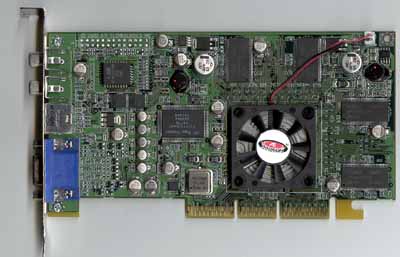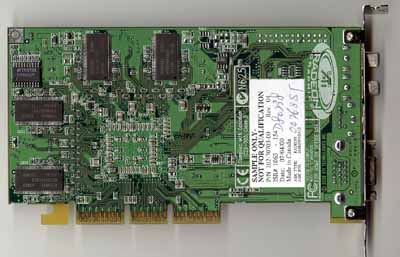The Card
The Radeon 64MB DDR and Radeon 32MB DDR, which will be available in retail locations by the time you are reading this, are the first installments of the Rage6C core. Look for a 32MB SDR version in the near future, however these cards are not shipping yet. We tested a 64MB DDR retail card.
Based on a .18 micron architecture, the core of the Radeon runs relatively cool. In fact, the card dissipates about 8W max power, about 4W more than that of the extremely cool GeForce 2 MX and 8W less than the hot running GeForce 256 chip. As a result of this cool running temperature, the heatsink and fan combination on the Radeon is rather small. We suspect that ATI did not need to even add the fan and/or heatsink but did so to improve the visual characteristics of the card: when one sees a card with out any form of active cooling, one usually assumes that it is a lower performing card.
With all the video input and output features of the card, there was no room to place a DVI connector on the board to take advantage of the core's built-in TMDS. We suspect that all DVI cards will be sold through OEM channels and will lack any of the VIVO features seen on this test card here. It will most likely be possible to pick up one of these cards in white-box OEM only version, but don't look for it on the retail shelves.
No other feature of the Radeon 64MB PCB board was noteworthy. Similar to many cards we have seen in recent months, the Radeon reference design has a plethora of capacitors and inductors to aid in power regulation.












2 Comments
View All Comments
Thatguy97 - Tuesday, May 5, 2015 - link
ahh i remember anadtechs jihad against atiwow im dating myself
Frumious1 - Monday, August 29, 2016 - link
I don't remember it at all. The only thing I recall is a bunch of whiny ass fanboys complaining when their chosen CPU, GPU, etc. didn't get massive amounts of acclaim. The very first Radeon cards were good, but they weren't necessarily superior to the competition. You want a good Radeon release, that would be the 9700 Pro and later 9800 Pro -- those beat Nvidia hands down, and AnandTech said as much.